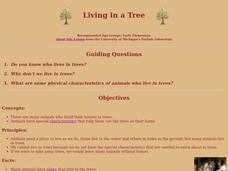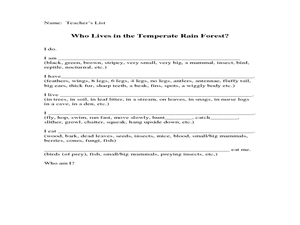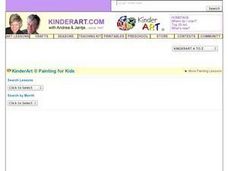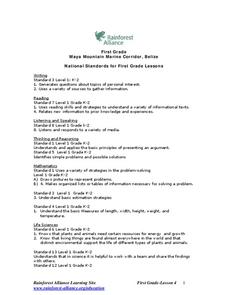Curated OER
Turtle and Tortoise Preschool Lesson Plan
One of the best parts about teaching the littlest learners is that you can create thematic lessons that use one topic to address every subject. Here is a nice set of thematic teaching ideas that uses turtles and tortoises to teach...
Umaine Museum of Art
Bony Fish Anatomy Worksheet
Take time to appreciate the beauty in the anatomy of animals with this cross-curricular art and science activity. After viewing examples of fish-themed artwork, children complete the included worksheet by labeling the...
Curated OER
Learning About Animal Shelters for Earth Day
Students explore habitats. in this ecology and animal habitat lesson, students listen to the book A House is a House for Me by Mary Ann Hoberman. Students discuss the basic needs of animals and go on a nature walk to observe animal...
Curated OER
Sustainable Livestock
Young scholars investigate healthy eating habits by researching livestock. In this food sustainability lesson, students research the negative impact factory farming has on our environment due to pollution. Young scholars define...
SeaWorld
Design a Fish
Craft some neat refrigerator magnets while studying ocean animals with a lesson about the anatomy of a fish. After kids learn about the different parts and shapes of fish, they use modeling compound to design their own fish.
Curated OER
Animal Habitats
Students explore animal lifestyles by researching their characteristics. In this animal habitat lesson, students read the story Over in the Jungle and analyze the animal illustrations in the book. Students create clay animal characters...
Curated OER
Local Habitats
Students create dioramas that depict a habitat. In this habitat lesson, students use a variety of art items to develop either a marine, freshwater/pond, or forest habitat in a box. They write an expository essay about their habitat, and...
Curated OER
Cardboard Tree and Endangered Animals Lesson
Students create endangered animal figures and their habitats.
Curated OER
Reptile and Amphibian Anatomy
Students identify and interpret the various differences between reptiles and amphibians. Then they draw an amphibian and reptile and correctly label their body parts. Students also invent new reptiles and amphibians, sketch how they...
Curated OER
Animal Habitat Dioramas
What a better way to have learners show what they know than with a diorama? Kids research an animal, its habitat, ecosystem, and environment in order to create a three-dimensional diorama. Have older children write a short paper on their...
Curated OER
Leaf-Motif Frame
Young scholars research leaves and their life cycle as well as their importance to the environment. After discussing photosynthesis, habitats, and nutrients for the soil, students collect and identify fallen leaves. Young scholars use...
Curated OER
King of Beasts
Students conduct research on lions and their natural habitats and how zoos provide lions with more natural surroundings while in captivity. They draw a picture of a lion in a habitat of their choice and add details to the scene's...
Curated OER
Living in a Tree
Students explore animals that live in trees. In this nature and biology lesson, students go outdoors and make observations about animals and their unique body parts that help them to live in trees. Students create drawings as they...
Curated OER
Layers of the Forest
Students explore rain forests. For this rain forest ecosystems lesson, students identify and describe the layers of the rain forest. Students paint and decorate a large rain forest mural. Students write riddles about animals that...
Curated OER
Animal Colors and Shapes
Students investigate the natural characteristics of animals by completing a coloring activity. In this animal properties lesson, students investigate the reasons different animals have specific colors, and how it is essential for...
Curated OER
Invent an Animal
Young scholars recognize how animal adaptations help animals survive in their environment. In this characteristics lesson, students create an original animal that can adapt to a specific habitat. Young scholars create a model of...
Curated OER
Activity Plan 4-5: Animal Habitats
Students investigate the world around them with this animal habitat activity. In this early childhood lesson plan, students create murals depicting animal habitats to encourage the development of science, geography, creative-thinking,...
Curated OER
A Matter of Survival
Fourth graders dance with inspiration from wild animals. For this creative movement lesson, 4th graders watch a video clip and then move like an animal might move in their natural surroundings.
Curated OER
Fish Banners
An art lesson involving fish can accent a wide variety of subjects. Here are the steps needed to create a fish banner with paint, shapes, cardboard, and paper. This would be a nice way to start or finish a unit on fish or underwater...
Curated OER
Where Are the Dinosaurs?
Young scholars explore the concept of extinction by studying dinosaurs. In this extinction lesson, students watch dinosaur video clips or complete a puppet finger play about dinosaurs. Young scholars may then complete a dinosaur diorama...
Curated OER
Dragonfly Sculptures
Art projects are great when they apply to other subjects. First study insects, their parts, and their habitats. Then have little ones create a dragonfly. They use clothes pins, raffia, pipe-cleaners, and paint to construct their...
Curated OER
Who Takes Care of the Maya Forest Corridor?
First graders study the animals in the Maya Forest Reserve. In this conservation lesson, 1st graders create a graph to compare the environment of animals to their own. They design a 3D model of these two environments.
Curated OER
I spy (Camouflaged Animals in Art!)
Students create a picture of a camouflaged animal in its habitat. In this visual arts lesson, students look at Hans Hoffmann's painting A Hare in the Forest and discuss the animal's camouflage. They research their own animal to...
Curated OER
Build a Polyp
Students research coral polyps. In this coral polyps lesson, students discover the anatomy of a coral polyp and how they feed. Students create an edible coral polyp model.























